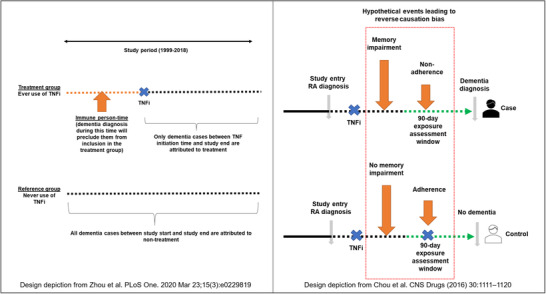FIGURE 3.

Immortal time bias (left) and reverse causation bias (right) in recent pharmacoepidemiologic studies evaluating associations between tumor necrosis factor (TNF)‐inhibitor use and the risk of Alzheimer's disease and related dementia (ADRD). Zhou et al. (left) compared the risk of ADRD between patients who were prescribed a TNF‐inhibitor any time in the study period prior to ADRD diagnosis versus those who were never prescribed these drugs in the study period. This “ever user” versus “never user” comparison is affected by immortal time bias because patients who are diagnosed with ADRD early on in the follow‐up period have less opportunity to be classified into the treatment group and thus, more cases end up in the “never user” group. Chou et al. (right) compared the risk of ADRD between individuals who received TNF‐inhibitor treatment versus those who did not in a 3‐month exposure assessment window before an AD diagnosis. This design is prone to substantial bias from reverse causation leading to spurious protective effect estimates because cognitive decline is plausibly accompanied by a decline in medication adherence
